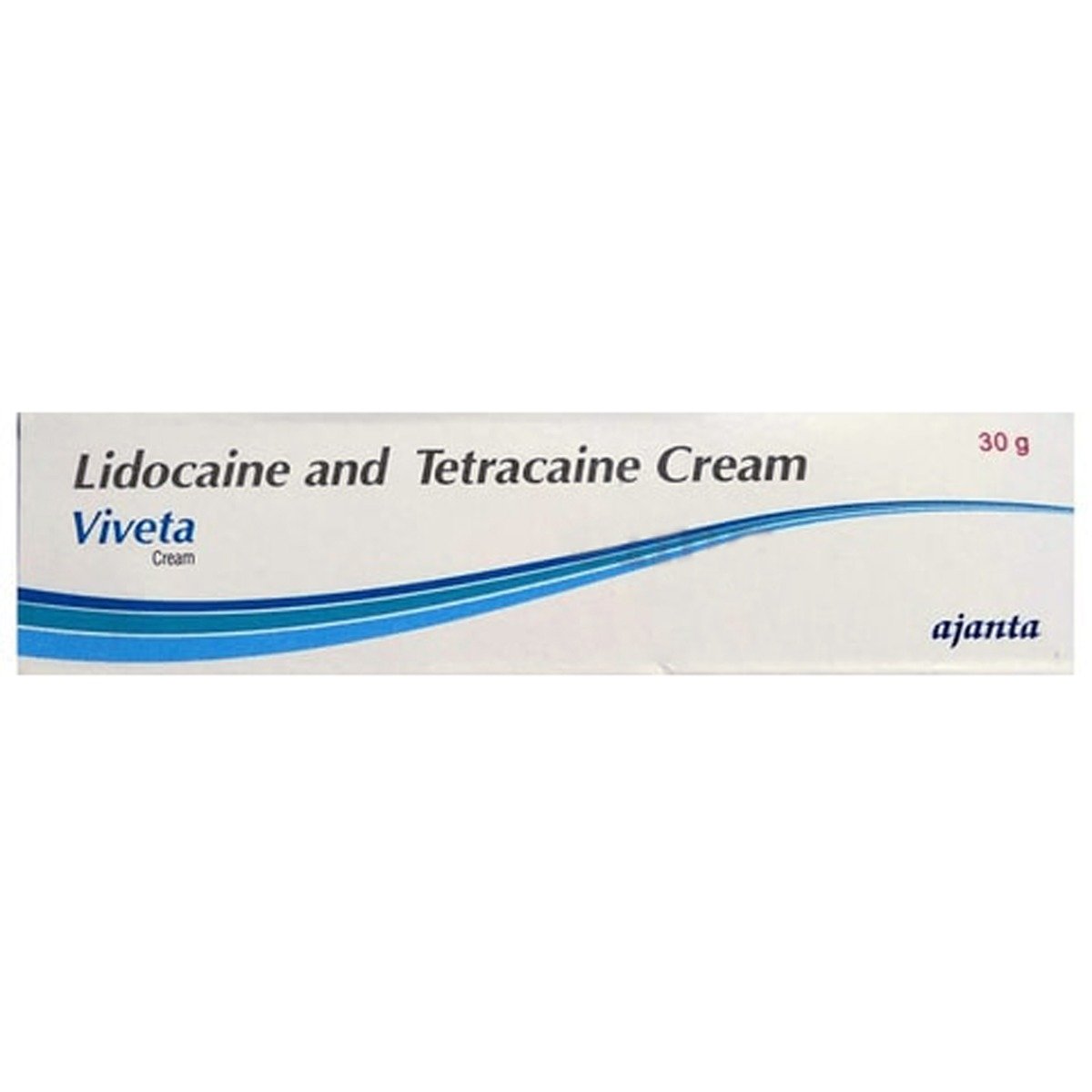Lidocaine+tetracaine
About Lidocaine+tetracaine
Lidocaine+tetracaine is a topical anaesthetic medication used to numb a specific area of the skin. It helps reduce pain and discomfort during certain skin procedures like laser treatments, tattoo removal, dermal filler injection (cosmetic injections to enhance facial features), and skin removal (biopsy) for testing.
Lidocaine+tetracaine contains two local anaesthetic medications: Lidocaine and Tetracaine. Both drugs work by blocking the sodium ion channels that allow nerves to send pain signals, which helps numb the area and reduce pain and discomfort.
Lidocaine+tetracaine is for external use only. Lidocaine+tetracaine causes common side effects, such as swelling, redness, and skin discolouration at the application site, in some individuals. These side effects are generally mild and will gradually resolve over time without the need for treatment. However, if these side effects worsen or persist, please consult your doctor.
Inform your doctor if you are allergic to any ingredients in Lidocaine+tetracaine, para-aminobenzoic acid, or other local anaesthetics. Avoid using Lidocaine+tetracaine for longer durations or on larger skin areas than recommended, as this may result in serious side effects. Before using Lidocaine+tetracaine, tell your doctor if you are pregnant, planning to become pregnant, or breastfeeding. Lidocaine+tetracaine is not recommended for individuals with methemoglobinemia (a severe blood disorder affecting the blood's ability to carry oxygen) or babies under 12 months of age who are being treated with methemoglobin-inducing agents. Inform your doctor if you have a history of severe liver disease, heart problems, a genetic disorder (pseudocholinesterase deficiency), or blood disorders before using Lidocaine+tetracaine.
Uses of Lidocaine+tetracaine
Medicinal Benefits
Lidocaine+tetracaine is a topical anaesthetic medication primarily used to numb a specific area of the skin to reduce pain during certain procedures, such as laser treatments, tattoo removal, dermal filler injection (cosmetic injections to enhance facial features), and skin removal (biopsy) for testing. It contains Lidocaine and Tetracaine. Both drugs work by blocking the sodium ion channels that allow nerves to send pain signals, which helps numb the area and reduce pain and discomfort.
Directions for Use
- Follow your doctor’s instructions on the dosage and timing of this medication to ensure safe and effective use.
- Take a small amount of Lidocaine+tetracaine on the fingertip and apply it to the clean and dry affected area as directed by your doctor.
- Avoid touching or rubbing the area after application.
- Wash your hands thoroughly before and after applying it.
Storage
Side Effects of Lidocaine+tetracaine
- Swelling, redness, and skin discolouration at the application site
Drug Warnings
Inform your doctor if you are allergic to any ingredients in Lidocaine+tetracaine, para-aminobenzoic acid, or other local anaesthetics. Do not apply Lidocaine+tetracaine to inflamed or broken skin or mucous membranes, including the eyes, nose, mouth, or anal/genital areas. Avoid using Lidocaine+tetracaine for longer durations or on larger skin areas than recommended, as this may result in serious side effects. Before using Lidocaine+tetracaine, tell your doctor if you are pregnant, planning to become pregnant, or breastfeeding. If you are breastfeeding, do not apply Lidocaine+tetracaine directly to the nipple or surrounding area. Lidocaine+tetracaine is not intended for children under 18, as its safety and effectiveness in this age group have not been established. It is also not recommended for individuals with methemoglobinemia (a severe blood disorder affecting the blood's ability to carry oxygen) or babies under 12 months of age who are being treated with methemoglobin-inducing agents. Inform your doctor if you have a history of severe liver disease, a genetic disorder (pseudocholinesterase deficiency), heart problems (irregular heartbeats), or blood disorders (methemoglobinemia) before using Lidocaine+tetracaine.
Drug Interactions
Drug-Drug Interactions: Lidocaine+tetracaine may interact with antiarrhythmic drugs (mexiletine, tocainide) and other local anaesthetics.
Drug-Food Interactions: No interactions were found/established.
Drug-Disease Interactions: If you have a history of severe liver disease, a genetic disorder (pseudocholinesterase deficiency), or blood disorders (methemoglobinemia), inform your doctor before using Lidocaine+tetracaine.
Drug-Drug Interactions Checker List:
Safety Advice

Alcohol
consult your doctorThe interaction of Lidocaine+tetracaine with alcohol is unknown. Please consult your doctor before consuming alcohol while using Lidocaine+tetracaine.

Pregnancy
consult your doctorIt is unknown whether Lidocaine+tetracaine affects pregnancy. Please consult your doctor before using Lidocaine+tetracaine if you are pregnant or planning to become pregnant. Your doctor will prescribe Lidocaine+tetracaine only if the benefits outweigh the risks.

Breast Feeding
consult your doctorIt is unknown whether Lidocaine+tetracaine passes into breast milk and affects the newborn. If you are breastfeeding, please consult your doctor for advice before using Lidocaine+tetracaine.

Driving
safeLidocaine+tetracaine does not affect your ability to drive.

Liver
cautionLidocaine+tetracaine should be used with caution in patients with severe liver disease. Inform your doctor if you have pre-existing liver problems before using Lidocaine+tetracaine.

Kidney
cautionLidocaine+tetracaine should be used with caution in patients with kidney disease. Inform your doctor if you have pre-existing kidney problems before using Lidocaine+tetracaine.

Children
consult your doctorThe safety and effectiveness of Lidocaine+tetracaine in children under 12 years old have not been established. Please consult your doctor before using Lidocaine+tetracaine in children.
Habit Forming
Diet & Lifestyle Advise
- Eat a healthy diet, manage stress, drink lots of water, exercise regularly, and get enough sleep.
- Avoid harsh soaps, lotions, or cleansers, as they can irritate the skin and reduce the effectiveness of the medication.
- Avoid exposing the treated skin area to extreme heat or cold.
- Resist the urge to scratch or pick at the treated area, as this can lead to irritation.
Patients Concern
Disease/Condition Glossary
Pain: Pain is an uncomfortable sensory and emotional response that can arise from injury or illness. It is typically managed using various methods, one of which involves local anesthesia. Local anesthesia involves the use of medications to block nerve signals in a targeted area of the body, temporarily numbing the region to prevent pain during procedures. This enables patients to undergo surgery or medical procedures without experiencing discomfort while staying conscious and alert.
FAQs
Lidocaine+tetracaine is used to numb a specific area of the skin to reduce pain during certain skin procedures.
Lidocaine+tetracaine contains two local anaesthetic medications: Lidocaine and Tetracaine. Both drugs work by blocking the sodium ion channels that allow nerves to send pain signals, which helps numb the area and reduce pain and discomfort.
The common side effects of Lidocaine+tetracaine include swelling, redness, and skin discolouration at the application site, in some individuals. These side effects are generally mild and will gradually resolve over time without the need for treatment. However, if these side effects worsen or persist, please consult your doctor.
Do not use Lidocaine+tetracaine if you are allergic to its ingredients. It is also not recommended for individuals with methemoglobinemia (a severe blood disorder affecting the blood's ability to carry oxygen) or babies under 12 months of age who are being treated with methemoglobin-inducing agents.
No, you should avoid using Lidocaine+tetracaine for longer durations or on larger skin areas than recommended, as this may increase the risk of serious side effects.



